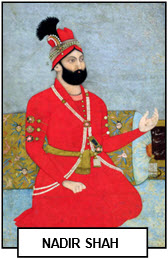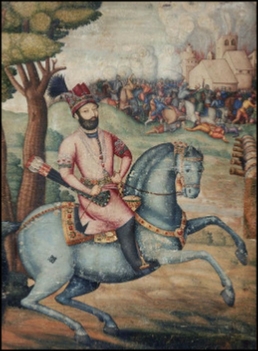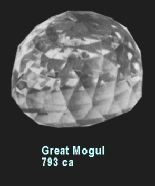


xxxxxAs we have seen, following the death of Aurangzeb in 1707 (AN), the great Mughal Empire, formed by Babur in 1526, began to break up, and the end came with the sacking of Delhi by Nadir Shah, the king of Iran, in 1739. He had come to power in the early 1720s when his country had been overrun by the Afghans, the Russians and the Turks in 1722 (G1). As a local bandit chief, he seized power from the ruling but discredited Safavids and, in a series of brilliant campaigns, drove the invaders out of Iran. Then taking the imperial crown as Nadir Shah, he conquered Afghanistan and, entering northern India, won the Battle of Karnal and captured Delhi. Amongst the vast amount of treasure he took home from there was the peacock throne and, more than likely, the famous Koh-
NADIR SHAH, RULER OF IRAN 1736 -
Acknowledgements
Nadir Shah: 1700/25, artist unknown – Victoria and Albert Museum, London. Delhi: mid-
G2-
 xxxxxAs we have seen, the death of its outstanding leader Aurangzeb in 1707 (AN) heralded the end of the great Mughal Empire, founded by Babur in 1526. Over the next thirty years central authority collapsed and the empire broke up into a large number of petty kingdoms and principalities. The coup de grace came in 1739 when Nadir Shah, the king of Iran, invaded northern India and plundered the capital city of Delhi. After that the empire -
xxxxxAs we have seen, the death of its outstanding leader Aurangzeb in 1707 (AN) heralded the end of the great Mughal Empire, founded by Babur in 1526. Over the next thirty years central authority collapsed and the empire broke up into a large number of petty kingdoms and principalities. The coup de grace came in 1739 when Nadir Shah, the king of Iran, invaded northern India and plundered the capital city of Delhi. After that the empire -
xxxxxNadir Shah (1688-
 xxxxxItxwas then, having assumed the imperial title as Nadir Shah, that in 1738 he occupied Kandahar and conquered almost the whole of Afghanistan before moving into northern India. Here, in February 1739, he defeated the Mughal armies at the Battle of Karnal and then swarmed into Delhi (illustrated). Having sacked the city and slaughtered 30,000 of its inhabitants, he took a vast amount of treasure back to Iran, including the famous peacock throne of Shah Jahan and -
xxxxxItxwas then, having assumed the imperial title as Nadir Shah, that in 1738 he occupied Kandahar and conquered almost the whole of Afghanistan before moving into northern India. Here, in February 1739, he defeated the Mughal armies at the Battle of Karnal and then swarmed into Delhi (illustrated). Having sacked the city and slaughtered 30,000 of its inhabitants, he took a vast amount of treasure back to Iran, including the famous peacock throne of Shah Jahan and -
xxxxxThis extraordinary spate of victories made Nadir Shah the most powerful sovereign in the Middle East, with an empire stretching from the Indus River to the Caucasus Mountains. Some saw him as the "Second Alexander", and he was later to be dubbed the "Napoleon of Persia". However, unlike the Safavid dynasty he replaced, his was to be short lived. A despotic and incredibly cruel ruler -
xxxxxFollowing his death, there was a period of relative peace and prosperity during the Zand dynasty, but from the beginning of the next century there followed years of progressive decay. Meanwhile, as we shall see, Ahmad Shah Durrani, the commander of Nadir Shah's Afghan bodyguard, was elected shah of Afghanistan in 1747 and, like his master before him, cast covetous eyes upon northern India in general and the city of Delhi in particular.
xxxxxIncidentally, it would certainly seem that Nadir Shah was only interested in war and conquest. The story goes that once, when told that there was no such thing as warfare in paradise, he is alleged to have replied: "How then can there be any delights there?"
xxxxxThere is some doubt as to whether the Koh-
whether the Koh-
Including:
The Great
Mughal
Diamond



